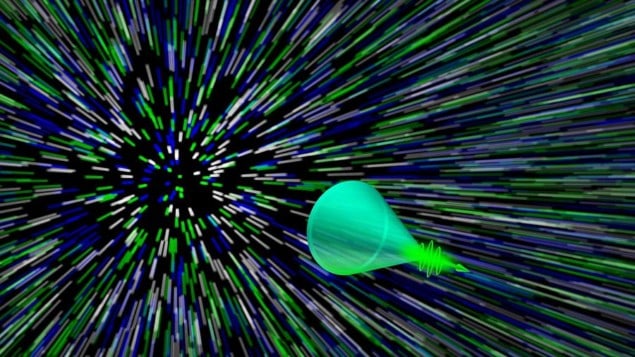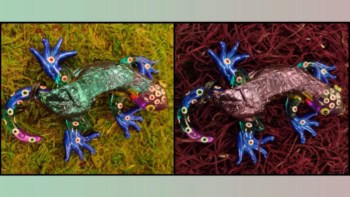
The optical equivalent of a sonic boom has been filmed for the first time. The feat involved two important breakthroughs, slowing the light to create the effect and developing an ultrafast imaging technique to record the phenomenon.
When a jet aircraft travels faster than the speed of sound (343 m/s), it produces an immensely loud sonic boom that can smash windows and set off car alarms. This phenomenon is related to pressure waves. As an object, such as an aircraft, pushes air out of the way, it creates pressure waves that move at the speed of sound. If the object also reaches the speed of sound, known as Mach 1.0, the waves build up and create a shock wave, or sonic boom. Continuing at or above Mach 1.0 means the sonic boom trails behind the object in a conical shape – called a Mach cone.
A Mach cone is created whenever a wave emitter travels faster than the waves it creates and therefore the event is not limited to sound. However, while the speed of sound is achievable by modern aircraft, bullets and even bullwhips, the same cannot be said for light. It is a fundamental law of physics that nothing travels faster than the speed of light in a vacuum (299,792,458 m/s). So how could an emitter travel faster? Lihong Wang and Jinyang Liang of Washington University in St Louis, the lead researchers on the current study, get around this problem by taking advantage of the fact that light will travel significantly slower when in a medium rather than a vacuum.
Appears faster than light
To create their Mach cone, the team made two display panels of silicone rubber doped with aluminium oxide powder. These flanked a thin channel containing air and dry-ice fog. A green laser pulse lasting 7 ps is fired down the channel. As the short laser pulse travels through the channel, the dry ice fog scatters some of the light into the panels. The speed of light in the display panels is slower than in the channel. Therefore the light is slowed as it travels through the panels above and below the channel, making it appear that the pulse is travelling faster than the scattered light. As the scattered wavelets of light superimpose in the panels, they create a wave front, analogous to the sonic boom shock wave, and a Mach cone of light is seen trailing behind.
Yet, even with this reduced speed, it is still difficult to record the propagation of the light in real time. “Capturing a photonic Mach cone’s movement in real time to produce an intuitive movie has been a long-standing challenge owing to the lack of single-shot light-speed 2D imaging,” say Wang and Liang. The feat of freezing light’s motion requires an imaging speed of a billion frames per second, but most cameras can only achieve 1000 frames per second. Furthermore, most ultrafast technologies are pump-probe devices. They take thousands of measurements that then need to be stitched together. These require the events to be accurately repeated, something that is not achievable for many physical events.
Ultrafast solution
To overcome these challenges, Wang, Liang and colleagues developed a single-shot ultrafast imaging technique to record the real-time propagation of a laser pulse travelling through a scattering medium.
For the imaging set-up, the group used lossless-encoding compressed ultrafast photography (LLE-CUP). The LLE-CUP system is a step on from past devices because it is ultrafast and takes only one snapshot. The set-up Liang and team used was a complex arrangement of optical devices that captured the event through three different cameras. The first camera recorded a direct image of the scene while the second two recorded temporal information. The combination allowed the scientists to reconstruct the scene frame by frame. The result is the first ever recording of a photonic Mach cone in real time.
The LLE-CUP system provides a new approach for recording complex, unique events in real time. It has particular potential in the field of biomedical imaging. “Our camera is fast enough to watch neurons fire and image the “live traffic” in the brain. We hope we can use our system to study neural networks to understand how the brain works,” say Wang and Liang.
The photonic light cone and LLE-CUP system are described in Science Advances.



